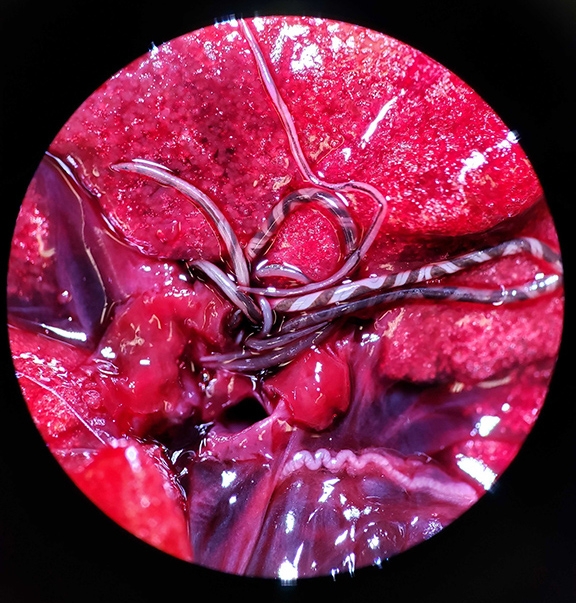Out of the tropics – the global spread of the rat lungworm
Parasitology are delighted that a special issue on Angiostrongylus will be published next year. In this blog post Professor Cowie from the University of Hawaiʻi gives us some insight into this parasite.
Rats, slugs, worms in your brain! What could be more gross? This is rat lungworm disease, or more technically, neuroangiostrongyliasis. The worm was first found in rats in southern China, back in 1935, but the connection to human disease was only made, by scientists working in Hawaii, in the 1960s, initially in patients who died after eating raw slugs!
But how are rats, worms and slugs connected, and how is the disease caused by eating raw slugs?
The key is the parasite, a worm known scientifically as Angiostrongylus cantonensis, or to the public as the rat lungworm – because the adult worms reproduce in the pulmonary system of rats. Slugs and snails are the other component of the worm’s natural developmental cycle. They are infected by larval worms when they feed on rat droppings, which many of them love. In turn, when a rat eats an infected slug it becomes infected with the developing larvae, which eventually reach its brain. There they feed and grow, almost reaching maturity, at which point they travel through the blood circulatory system to the heart and pulmonary arteries, where they mature fully and reproduce. And the cycle repeats.

How does this cause disease in people? It’s pretty disgusting and horrible. If a person eats an infected raw snail or slug, the worms reach their brain but are unable to fully develop and die. The damage to the brain caused by their feeding and moving around, combined with major inflammation, especially when the worms die, is what causes the symptoms of disease. These are usually a splitting headache that won’t go away, extraordinarily sensitive skin with severe tingling like pins and needles over different parts of the body, aching neck and shoulders, and in more serious cases urinary and digestive tract problems, loss of balance and muscle control, and visual impairment, among other things; in really serious cases, coma and even death may ensue; and people who survive a serious case may suffer significant long term consequences.
But why would anyone actually eat a raw snail and especially a raw slug?! Most human cases have been in parts of China and Thailand, where raw snails are considered a delicacy by some people. People have even eaten raw snails or slugs on a dare or for a bet – always men, and in most cases they had been drinking (alcoholic drinks, that is). In Hawaii and other places where people do not normally eat raw snails, infection is probably most often by accidentally eating a small one hiding in a salad, for instance. So make sure to thoroughly wash your produce if you live in a region where the disease is endemic. Other ways of becoming infected have also been suggested. Cooking or freezing kills the parasite (and of course the snail or slug that it was in).
The rat lungworm is also widespread on many islands of the Pacific, in the Caribbean, and in parts of South America, Australia and elsewhere. In Hawaii, there have been around 150 documented cases of the disease since it was first reported, although probably many more that have remained unreported, but thankfully there have been very few deaths. In the mainland United States, the parasite is present in rats and snails and slugs in the southeast but there have only been a handful of cases of human disease since the first in the 1990s.
At present rat lungworm disease is considered a tropical and subtropical disease, as the worm itself is constrained by its need for warm temperatures. But there are hints that it is spreading into regions that were previously too cold for it, and projections, for instance in China and the United States, indicate that it will spread northwards as the climate warms. It may soon reach continental Europe – it is already in the Canary islands and Mallorca. A related worm, Angiostrongylus vasorum, sometimes known as the “French heartworm” because it was first discovered in southern France, and which also uses snails and slugs for part of its life cycle, causes disease in foxes and domestic dogs and is spreading rapidly through most of Europe, from the UK to Romania.
Rat lungworm disease is considered by epidemiologists as an “emerging infectious disease” – arguably it has already emerged in places like China, Thailand and Hawaii – but still also as a “neglected tropical disease” that warrants much greater attention from governments and international agencies.
If this blog post piqued your interest why not check out this short interview with Professor Cowie: https://www.youtube.com/watch?v=9fjJgPZ13dE, as well as this more in-depth interview: https://www.youtube.com/watch?







I’ve a 77 Yr old friend who’s convinced she’s had rat lungworm for years yet no one believes her.
Awful headaches and coughs.
Lots of illness but no one wants to test her and she’s convinced she’ll die as a result as they move all inside her